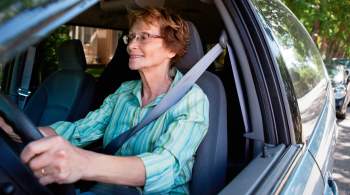
Addressing driving concerns and integrating clientcentered decisions can broaden a client’s options.
The concern for the safety and independence of older drivers is greater now than any time in our history. More than 10,000 Baby Boomers turn 65 each day, a trend expected to continue for the next 19 years. And, by the year 2040, one in five Americans will be age 70 years or older.
Current estimates are that men will outlive their driving life by 7 years and women by 10 years. This means each person planning to age at home will do so for some period of time beyond the ability to drive independently. Aging in place cannot be optimized unless transportation considerations are a priority.
For many who face the changes associated with aging—and who also have significant medical conditions—the loss of a driver’s license is feared as catastrophic and life altering. Underscoring the value seniors place on driving, delegates to the 2005 White House Conference on Aging identified transportation as the third highest priority challenging the aging senior’s quality of life. According to an AARP Household Survey 2011, caregiver responsibilities for providing or managing transportation are one of the top contributors to caregiver stress and a prominent factor contributing to the eventual decision to move a loved one into a care facility.
OCCUPATIONAL THERAPY AND DRIVING
Occupational therapy addresses driving as an instrumental activity of daily living. For clients who want to stay in their home—age in place—it is within the scope of practice for the occupational therapy evaluation and intervention to address the skills and abilities fundamental to their transportation goals, be it as driver or passenger.
The occupational therapy driving rehabilitation specialist (OTDRS) must look critically at the ability to safely control a vehicle within licensing guidelines established for all drivers. When, for example, intervention to restore strength, flexibility, or reaction time is not enough, referral to a driving rehabilitation specialist opens the door to the exploration of adaptations such as hand controls.
The recommendation to stop driving occurs only when the client cannot demonstrate adequate functional abilities, through restoration, adaptation, or equipment modification, to safely manage the vehicle. Sadly, intervention to address functional driving limitations often occurs too late if at all, missing the window of opportunity for greater rehabilitation potential.
Developing a plan within each rehabilitation program for addressing driving and community mobility concerns brings the services of clinicians, driving rehabilitation specialists, and community mobility providers into the client’s array of options.
Client-centered decisions for the medically at-risk driver choosing to age in place must involve a process that considers the client’s goals and abilities, and environment. This decision-making process must explore the range of options for transportation, extending beyond driving to include family, friends, and community transportation providers. Rehab managers have the opportunity and responsibility to ensure that their programs are equipped to address transportation solutions, whether directly or through referral, for drivers who wish to age in place.
For example, the driver with arthritis may safely come and go from her home with ease once the ramp between house and garage eliminated the steps. She stows her scooter using a piece of equipment called a scooter lift, closes and locks the doors electronically, and drives off using a modified steering system called low effort steering, which reduces her effort to steer by as much as 40%, minimizing pain and trauma to her shoulders while optimizing her ability to maneuver quickly and accurately. The driver with Parkinson’s disease may drive longer after the OTDRS offers training during an on-road experience using an evaluation vehicle equipped with an instructor brake to optimize safety for the driver and evaluator. This on-road experience allows the driver to experience, in context, the impact of impaired motor initiation on the ability to move swiftly from gas to brake and the limited performance window medications may offer. The family of the person with early onset dementia may be comforted by strategies that include technology such as a vehicle connectivity system that offers the ability to locate a lost driver by tracking the vehicle. Other strategies include a restricted driving radius to familiar routes and no highways, and a difficult but essential family discussion producing a contract that captures the client’s wishes and identifies an agreed upon plan for giving up the keys.
A NEW CHALLENGE
Driving rehab programs have existed nationally in rehabilitation centers, the US Department of Veteran Affairs, and private practices dating back to nearly the invention of the car itself. Did you know that President Franklin D. Roosevelt drove his car with hand controls?
Today’s driving rehabilitation programs face the emerging expectation to address the driving competence of drivers who have diminishing skills. Clients aging in place may be managing medical conditions that impair—to varying degrees—the subskills of vision, physical ability, and cognition that evidence demonstrates are critical for safe driving, according to the AMA Physician’s Guide to Assessing and Counseling Older Drivers, National Highway Traffic Safety Administration (NHTSA), 2011. The driving environment adds to the challenge, with roadways now increasingly congested and complex. Drivers with unaddressed and uncompensated impairments may create a threat not only to themselves but to the community at large.
The question of driving safety is moving to the forefront of issues requiring professional evidence-based decisions that consider the importance of driving in the client’s life and the ability to age in place. Driving decisions must integrate medical information, evaluation data, and client expectation while taking into consideration personal choice, the ethical obligation to report, and state licensing standards.
EXERCISE AND WELLNESS

Adaptive controls and vehicle modification can provide patients “aging in the community” with a new lease on life.
The importance of home exercise cannot be overemphasized when discussing “aging in place.” Flexibility, strength, range of motion, and stamina are critical to safely controlling a vehicle. Transportation requires a combination of walking, standing, sitting, and “stepping up.” Adaptation is costly and should be considered only when an acceptable level of physical function cannot be attained. As added “incentive” to the home exercise program that may include exercise bands or foam rollers, consider clearly addressing the relationships to driving such as “rotating the trunk required for an over the shoulder blind-spot check or moving the foot deftly as if managing gas and brake.” Safe transportation requires an individual to maintain total body strength and fitness, from walking to the garage to climbing into the vehicle followed by reaching for the door and seatbelt. Mobility devices must be lifted and secured. Sustained shoulder flexion is required to keep hands on the wheel. An individualized combination of home exercise, awareness, compensatory strategies, and equipment may contribute to successful and productive aging in place.
DRIVING EQUIPMENT AND ADAPTATIONS
Aging in place could alternatively be called “aging in community,” and access to the community assumes access to transportation. Trips to the store, medical appointments, and the hairdresser may tap a variety of modes of transportation.
The driver who uses a scooter maintains regular participation employed as a Walmart greeter. Aided by the right equipment that preserves his mobility, that same individual maintains status as a long-standing card club member. Despite the residual hemiparesis following his stroke, he now drives his vehicle using adaptive controls and transports his scooter using the mechanical scooter lift he manages by simply applying a hook and pressing a lever.
The driver with diabetic neuropathy and the pain that led to right toe amputation was given what she described as a “new lease on life” when the fear of managing the gas and brake with the foot she could no longer feel was transformed to the thrill of learning to drive with hand controls (adaptive equipment that allows the driver to control accelerator and brake using only the hands).
“Caregiver” was the new life role for the wife of an 84-year-old man with advancing Parkinson’s disease. They loved to picnic by their neighborhood lake, but the transfers in and out of the vehicle were taking a toll on her arthritic shoulders and back. The couple feared becoming homebound, and she felt terrified she might “drop him” when transferring him into the car. The couple invested in a vehicle modification of a swing-out passenger seat, which reduced the demands of her husband’s assisted transfer to within her capabilities. Not only could they resume afternoon visits to the lake, but maintaining residence in their home was once again a possibility.
EDUCATION IS AVAILABLE
CarFit (www.Car-Fit.org) is an education program developed and designed as a turnkey model available free of charge for any community. CarFit trains community volunteers to run through a brief 12-point checklist that reviews the basic safety features of the person’s vehicle with attention to person-vehicle fit. Key points include seatbelt use, visibility (line of sight above dashboard and steering wheel and use of mirrors), safe distance from steering wheel (housing the airbag), and seat adjustment. Some drivers cannot achieve optimal comfort or fit through basic adjustment alone. For these drivers, the CarFit check-up concludes with an occupational therapy practitioner (or rehabilitation professional) having a conversation with the driver experiencing changes associated with aging and/or medical conditions that may interfere with safe driving. The goal of this conversation is education and to build awareness of rehabilitation services, not “therapy” or evaluation.
The discussion in the context of CarFit is simply to increase the driver’s awareness of how their safety and occupant protection might be enhanced. The CarFit attendee receives a bag describing an array of resources that may include a listing of local driver safety classes, printed descriptions of local rehabilitation services, Web sites, and specialized driving rehabilitation programs. This nonthreatening approach encourages conversations about driving. The participation of rehab professionals at the CarFit event builds awareness of rehabilitation as a resource available in the community.
Practitioners learn from drivers. Rehabilitation professionals volunteering at CarFit events have the opportunity to better understand some of the challenges facing the aging driver. For example, we learned through CarFit conversations that some drivers do not use the seatbelt because of fear or discomfort. For some drivers with arthritis, it is too painful to rotate the trunk far enough to reach the seatbelt, or stiffness in the fingers results in fear that they would be unable to release the seatbelt in an emergency. Participants with these types of concerns are offered education about simple adaptations (eg, a ribbon attached to the seatbelt) or compensation strategies (eg, manage the buckle with the heel of the hand). With increased awareness of strategies and equipment, the hope is that drivers subsequently wear their seatbelts, benefit from the safety features of their vehicles, and attain optimal person-to-vehicle fit.
TRANSPORTATION: A PRIORITY FOR SUCCESSFUL AGING IN PLACE
Making transportation a core consideration is critical to successful rehabilitation outcomes.
The AOTA offers a wide array of resources to encourage driving program development and expansion. The newly funded Gaps and Pathways project between the AOTA and NHTSA stresses the importance of criteria-based intervention or referral to area driving rehab programs equipped to meet individual needs. Driver rehabilitation is a specialized field with several tiers of services and specialization.
AOTA’s Older Driver Safety Awareness Week began with the vision to build awareness among the occupational therapy community, but quickly gained wide interest among other organizations and communities. Community efforts to address driving and community mobility “require a village,” recognizing that transportation underlies all participation outside of the home.
Finally, as evidenced by media exposure of the rare but catastrophic incidents of older driver crashes, we must acknowledge that safe driving decisions cannot be deferred to personal choice, the family, the physician, or the state licensing authority alone. But by working collaboratively in support of clients’ goals and the needs of the community at large for safe and accessible transportation, older drivers can confidently age in place.
Elin Schold Davis, OTR/L, CDRS, is the coordinator of the American Occupational Therapy Association’s Older Driver Initiative. Founded in 1917 and based in Bethesda, Md, AOTA represents the professional interests and concerns of more than 140,000 occupational therapists, assistants, and students nationwide. For more information, contact .





